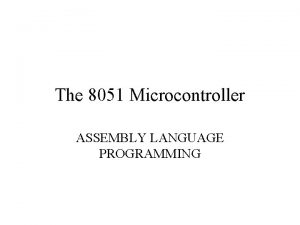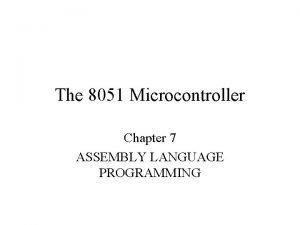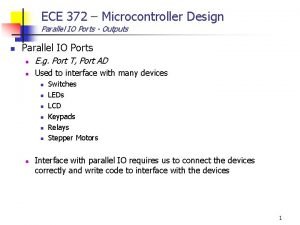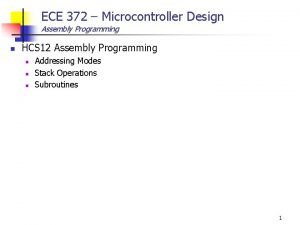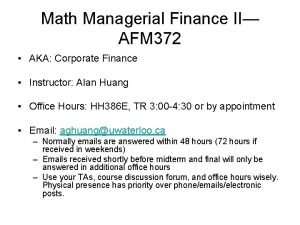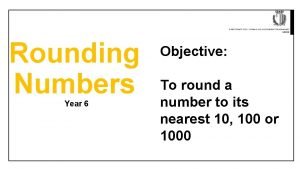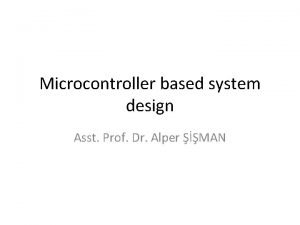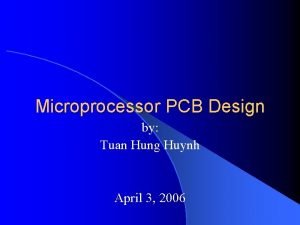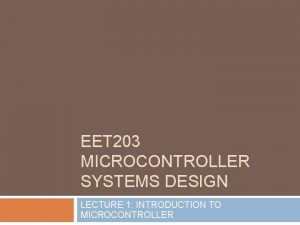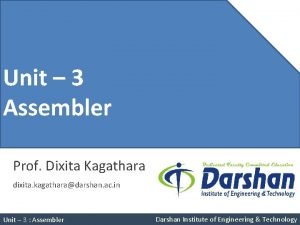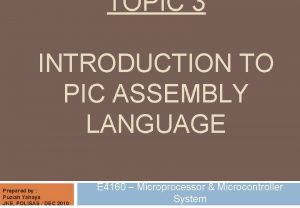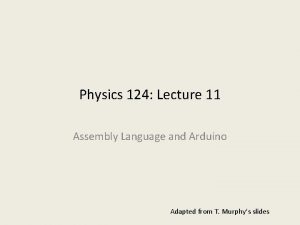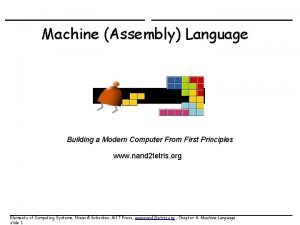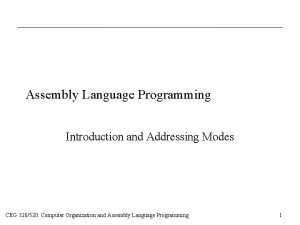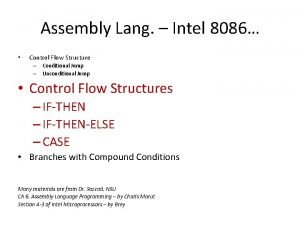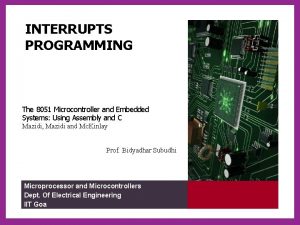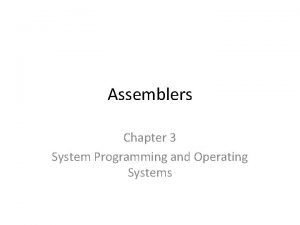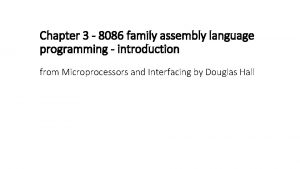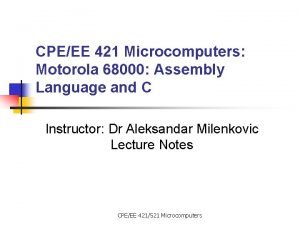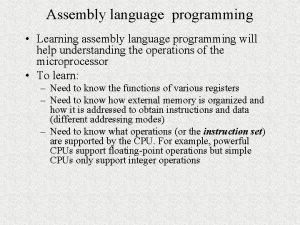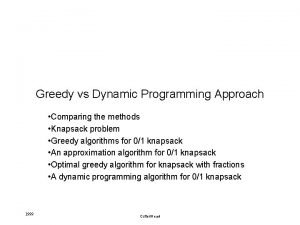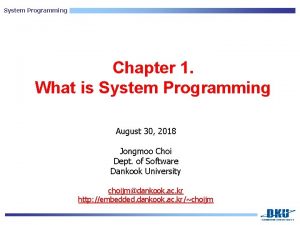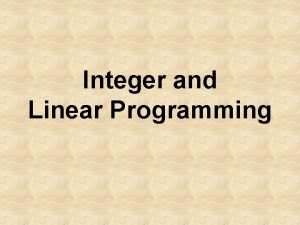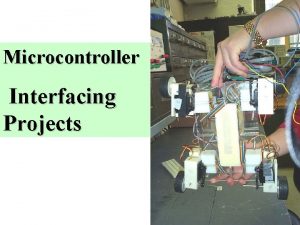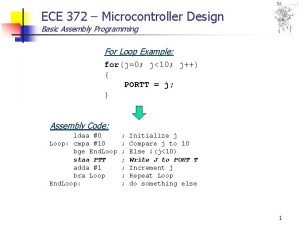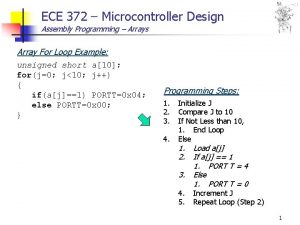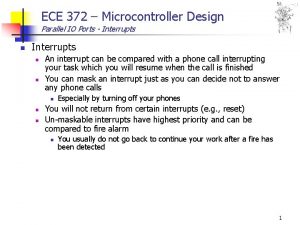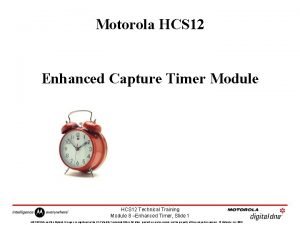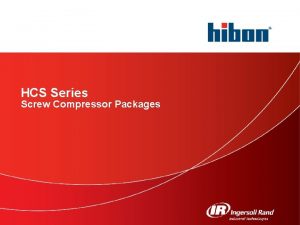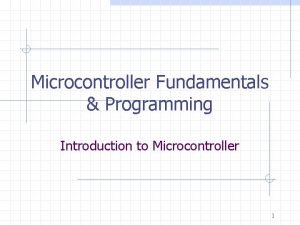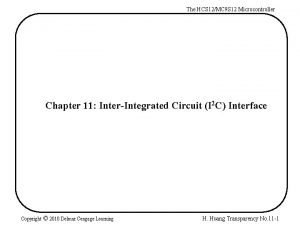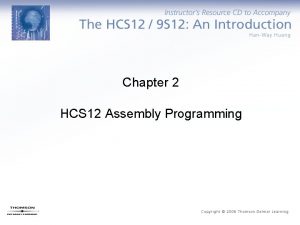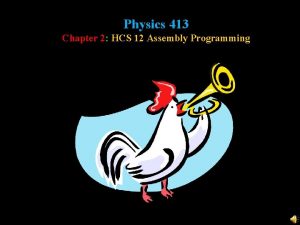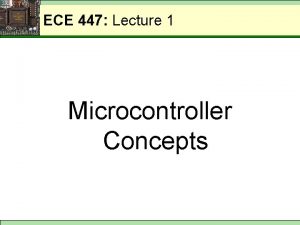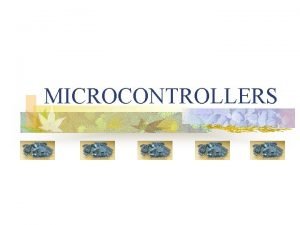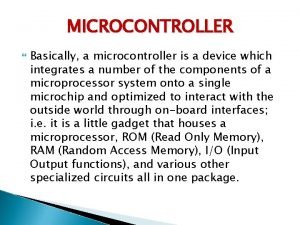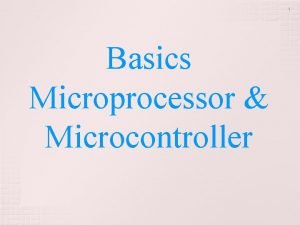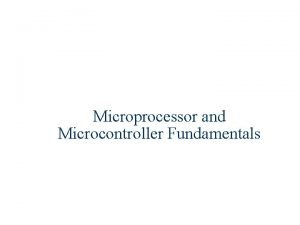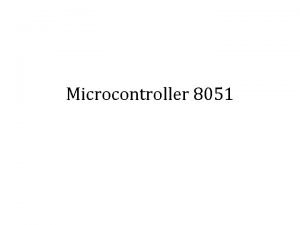ECE 372 Microcontroller Design Assembly Programming n HCS

ECE 372 – Microcontroller Design Assembly Programming n HCS 12 Assembly Programming n n n Addressing Modes Stack Operations Subroutines 1

ECE 372 – Microcontroller Design Assembly Programming – Addressing Modes n n n n Inherent Immediate Direct Addressing Extended Addressing Indexed Addressing PC Relative Addressing 2

ECE 372 – Microcontroller Design Assembly Programming – Addressing Modes n Inherent Addressing n n n No operand field (operands are implicit) Instructions have no operand or all operands are internal CPU registers Examples: n n mul – D = A * B idiv – X = D / X and D = D % X inca – A = A + 1 nop – No operation 3

ECE 372 – Microcontroller Design Assembly Programming – Addressing Modes n Immediate Addressing n n n Operands are constant values Operand is included in the instruction stream (ROM) No additional memory is needed (other than fetching instruction itself) Can be 8 -bit or 16 -bit value (usually depends on instruction) Examples: n cmpa #10 – Compare A with 8 -bit constant value 10 n n adda #$10 – Add 8 -bit constant value 16 to A n n Machine Code: $81 0 A Machine Code: $86 10 cpd #$0100 – Compare D with 16 -bit constant value 256 n Machine Code: $8 C 01 00 4

ECE 372 – Microcontroller Design Assembly Programming – Addressing Modes n Direct Addressing n n 8 -bit address provided along with instruction Address directly points to memory location of operand 8 -bit addresses can access memory locations from $0000 to $00 FF Examples: n ldaa 50 – Load A with Mem[50] n n adaa $FF – Add to A the value stored at Mem[255] n n Machine Code: $96 32 Machine Code: $9 B FF staa 128 – Store A to Mem[128] n Machine Code: $5 A 80 5

ECE 372 – Microcontroller Design Assembly Programming – Addressing Modes n Extended Addressing n n Similar to direct addressing but with 16 -bit address Address directly points to memory location of operand 16 -bit addresses can access memory locations from $0000 to $FFFF Examples: n ldaa $1000 – Load A with Mem[4096] n n adaa $0100 – Add to A the value stored at Mem[256] n n Machine Code: $B 6 10 00 Machine Code: $BB 01 00 staa $3800 – Store A to first RAM location of MC 9 S 12 C 32 (Mem[14336]) n Machine Code: $7 A 38 00 6

ECE 372 – Microcontroller Design Assembly Programming – Addressing Modes n PC Relative Addressing n n Used for branch instructions 8 -bit signed offset used for short branch instructions 16 -bit signed offset used for long branch instructions When instruction is fetched, the PC already points to the next instruction n PC + 2 for most short branch instructions PC + 4 for most long branch instructions Examples: n beq $04 – Branch if equal to PC + 2 + 4 n n Machine Code: $27 04 beq $FC – Branch if equal to previous instruction at PC + 2 - 4 n n -4 = $FC (11111100) Machine Code: $27 FC 7

ECE 372 – Microcontroller Design Assembly Programming – Addressing Modes n PC Relative Addressing Assembly Code: ldaa #0 ; Initialize j Loop: cmpa #10 ; Compare j to 10 bge End. Loop ; Else !(j<10) ; do something adda #1 ; Increment j bra Loop ; Repeat Loop End. Loop: ; do something else $4000 $4001 $4002 $4003 $4004 $4005 $4006 $4007 $86 $00 $81 $0 A $2 C ? ? $8 B $01 LDAA immediate addressing Value to be stored in A CMPA immediate addressing Compare Value 10 BGE (Branch if greater than or equal) PC=PC+2+Rel ADDA immediate addressing Value to add to A $4008 $4009 … $20 ? ? Branch Always PC=PC+2+Rel How do we calculate these values? 8

ECE 372 – Microcontroller Design Assembly Programming – Addressing Modes n PC Relative Addressing Assembly Code: ldaa #0 ; Initialize j Loop: cmpa #10 ; Compare j to 10 bge End. Loop ; Else !(j<10) ; do something adda #1 ; Increment j bra Loop ; Repeat Loop End. Loop: ; do something else PC = PC + 2 + Rel $400 A = $4004 + 2 + Rel = $400 A - $4004 -2 Rel = 4 ($04) $4000 $4001 $4002 $4003 $4004 $4005 $4006 $4007 $86 $00 $81 $0 A $2 C ? ? $8 B $01 LDAA immediate addressing Value to be stored in A CMPA immediate addressing Compare Value 10 BGE (Branch if greater than or equal) PC=PC+2+Rel ADDA immediate addressing Value to add to A $4008 $4009 … $20 ? ? Branch Always PC=PC+2+Rel PC = PC + 2 + Rel $4002 = $4008 + 2 + Rel = $4002 - $4008 - 2 Rel = -8 ($F 8) 9

ECE 372 – Microcontroller Design Assembly Programming – Addressing Modes n PC Relative Addressing Assembly Code: ldaa #0 ; Initialize j Loop: cmpa #10 ; Compare j to 10 lbge End. Loop ; Else !(j<10) ; do something adda #1 ; Increment j bra Loop ; Repeat Loop End. Loop: ; do something else PC = PC + 4 + Rel $400 C = $4004 + Rel = $400 C - $4004 - 4 Rel = 4 ($04) $4000 $4001 $4002 $4003 $4004 $4005 $4006 $4007 $86 $00 $81 $0 A $18 $2 C ? ? LDAA immediate addressing Value to be stored in A CMPA immediate addressing Compare Value 10 LBGE PC=PC+4+Rel Relative Value $4008 $4009 $400 A $400 B … $8 B $01 $20 ? ? ADDA immediate addressing Value to add to A Branch Always PC=PC+2+Rel PC = PC + 2 + Rel $4002 = $400 A + 2 + Rel = $4002 - $400 A - 2 Rel = -10 ($F 6) 10

ECE 372 – Microcontroller Design Assembly Programming – Addressing Modes n Indexed Addressing n Address is based of o value stored within register (S) n n Typically based on X or Y index registers (not required) Many index addressing modes exist n n n 5/9 -bit Constant Offset Auto Pre/Post Decrement/Increment 16 -bit Constant Offset 16 -bit Indirect Indexed Accumulator Offset Accumulator D Indirect 11

ECE 372 – Microcontroller Design Assembly Programming – Addressing Modes n 5/9/16 -bit Constant Offset Indexed Addressing n n Calculates addressed based on index register, stack pointer, or PC Address is 5/9/16 -bit offset added to address within X/Y/SP/PC n n Offsets are assumed to be signed values Example n n n ldaa 0, X – Load A with value stored at Mem[X+0] (5 -bit) stab -8, Y – Store B to Mem[Y-8] (5 -bit) stab -20, Y – Store B to Mem[Y-20] (9 -bit) 12

ECE 372 – Microcontroller Design Assembly Programming – Addressing Modes n Accumulator Offset Indexed Addressing n n n Calculates addressed based on index register, stack pointer, or PC and accumulators A, B, or D Address is the unsigned A/B/D offset added to address within X/Y/SP/PC Example n n ldaa B, X – Load A with value stored at Mem[X+B] stab D, Y – Store B to Mem[Y+D] 13

ECE 372 – Microcontroller Design Assembly Programming – Addressing Modes n 16 -bit Constant Indirect Indexed Addressing n Calculates indirect address based on index register, stack pointer, or PC and a 16 -bit offset n n n Indirect address points to memory location of pointer providing memory address of operand Direct address is value stored in memory location provided by indirect address Example n ldaa [10, X] – Load A with value stored at Mem[X+10]] n n If X = $1000 and Mem[$100 A: $100 B] = $2000 Indirect address = X+10 = $1000 + $0 A = $100 A Direct Address = Mem[$100 A] = $2000 A = Mem[$2000] 14

ECE 372 – Microcontroller Design Assembly Programming – Addressing Modes n Accumulator D Indirect Indexed Addressing n Calculates indirect address based on index register, stack pointer, or PC and 16 -bit accumulator D n n n Indirect address points to memory location of pointer providing memory address of operand Direct address is value stored in memory location provided by indirect address Example n ldaa [D, X] – Load A with value stored at Mem[X+D]] n n If X = $1000, D = $0 C, and Mem[$100 C: $100 D] = $3800 Indirect address = X+12 = $1000 + $0 C = $100 C Direct Address = Mem[$100 C] = $3800 A = Mem[$3800] 15

ECE 372 – Microcontroller Design Assembly Programming – Addressing Modes n Auto Pre/Post Decrement/Increment Indexed Addressing n n Calculates address based on index register or stack pointer Provides four methods for automatically adjusting the index register during the instruction n Pre-decrement/Pre-Increment n n Post-decrement/Post-Increment n n n Decrements or Increments the index register before calculating address Decrements or Increments the index register after calculating address Can be decremented/increment in ranges from -1 to -8 and 1 to 8 Example n n ldaa 1, -X – Load A with value stored at Mem[X-1], X = X - 1 staa 2, X+ – Store A to Mem[X], X = X + 2 16

ECE 372 – Microcontroller Design Assembly Programming n Create an assembly program to add together two 32 -bit unsigned numbers stored in memory at location $3800 and $3804 storing the result in location $3808. 17

ECE 372 – Microcontroller Design Assembly Programming – Stack Pointer n Stack Pointer (SP) n n Points to memory location corresponding to the top of the stack Must be initialized within your assembly program Initialize to location $4000 for MC 9 S 12 C 32 Basic Stack Pointer Instructions n n n des – Decrement stack pointer (SP) ins – Increment stack pointer (SP) psha/pshb/pshd/pshx/pshy – Push A/B/D/X/Y to stack n n pula/pulb/pulx/puly – Pull (Pop) A/B/D/X/Y from stack n n n Automatically adjusts stack pointer lds – Load stack pointer (SP) with from memory (or immediate value) sts – Store stack pointer (SP) to memory 18

ECE 372 – Microcontroller Design Assembly Programming – Stack Pointer n Storing and Retrieving from top of Stack n n Utilized stack to store temporary data Push data onto stack Pop data from stack Example: ldaa #0 psha ldaa #20 psha ldd #300 pshd ; ; ; A = 0 Push A(0) onto stack A = 20 Push A(20) onto stack D = 300 Push D(300) onto stack . . . puld pula pulb ; D = 300 ; A = 20 ; B = 0 SP: $4000 $3 FFF … $3 FF 9 $3 FFA $3 FFB $3 FFC $3 FFD $3 FFE $3 FFF $4000 … 00 19

ECE 372 – Microcontroller Design Assembly Programming – Stack Pointer n Storing and Retrieving from top of Stack n n Utilized stack to store temporary data Push data onto stack Pop data from stack Example: ldaa #0 psha ldaa #20 psha ldd #300 pshd ; ; ; A = 0 Push A(0) onto stack A = 20 Push A(20) onto stack D = 300 Push D(300) onto stack . . . puld pula pulb ; D = 300 ; A = 20 ; B = 0 SP: $3 FFE $3 FFF … $3 FF 9 $3 FFA $3 FFB $3 FFC $3 FFD $3 FFE $3 FFF $4000 … 14 00 20

ECE 372 – Microcontroller Design Assembly Programming – Stack Pointer n Storing and Retrieving from top of Stack n n Utilized stack to store temporary data Push data onto stack Pop data from stack Example: ldaa #0 psha ldaa #20 psha ldd #300 pshd ; ; ; A = 0 Push A(0) onto stack A = 20 Push A(20) onto stack D = 300 Push D(300) onto stack . . . puld pula pulb ; D = 300 ; A = 20 ; B = 0 SP: $3 FFC $3 FFE … $3 FF 9 $3 FFA $3 FFB $3 FFC $3 FFD $3 FFE $3 FFF $4000 … 01 2 C 14 00 21

ECE 372 – Microcontroller Design Assembly Programming – Stack Pointer n Storing and Retrieving from top of Stack n n Utilized stack to store temporary data Push data onto stack Pop data from stack Example: ldaa #0 psha ldaa #20 psha ldd #300 pshd ; ; ; A = 0 Push A(0) onto stack A = 20 Push A(20) onto stack D = 300 Push D(300) onto stack . . . puld pula pulb ; D = 300 ; A = 20 ; B = 0 SP: $3 FFE $3 FFC … $3 FF 9 $3 FFA $3 FFB $3 FFC $3 FFD $3 FFE $3 FFF $4000 … 01 2 C 14 00 22

ECE 372 – Microcontroller Design Assembly Programming – Stack Pointer n Storing and Retrieving from top of Stack n n Utilized stack to store temporary data Push data onto stack Pop data from stack Example: ldaa #0 psha ldaa #20 psha ldd #300 pshd ; ; ; A = 0 Push A(0) onto stack A = 20 Push A(20) onto stack D = 300 Push D(300) onto stack . . . puld pula pulb ; D = 300 ; A = 20 ; B = 0 SP: $3 FFF $3 FFE … $3 FF 9 $3 FFA $3 FFB $3 FFC $3 FFD $3 FFE $3 FFF $4000 … 14 00 23

ECE 372 – Microcontroller Design Assembly Programming – Stack Pointer n Storing and Retrieving from top of Stack n n Utilized stack to store temporary data Push data onto stack Pop data from stack Example: ldaa #0 psha ldaa #20 psha ldd #300 pshd ; ; ; A = 0 Push A(0) onto stack A = 20 Push A(20) onto stack D = 300 Push D(300) onto stack . . . puld pula pulb ; D = 300 ; A = 20 ; B = 0 SP: $4000 $3 FFF … $3 FF 9 $3 FFA $3 FFB $3 FFC $3 FFD $3 FFE $3 FFF $4000 … 00 24

ECE 372 – Microcontroller Design Assembly Programming – Arrays Array For Loop Example: Assembly Code: unsigned short a[10]; for(j=0; j<10; j++) { if(a[j]==1) PORTT=0 x 04; else PORTT=0 x 00; } ldaa #0 ldx #$3800 Loop: cmpa #10 bge End. Loop staa $3814 ldd 0, X cpd #1 bne Else ldab #4 bra End. If Else: ldab #0 End. If: stab PTT ldaa $3814 adda #1 inx bra Loop End. Loop: Programming Steps: 1. 2. 3. 4. Initialize J Compare J to 10 If Not Less than 10, 1. End Loop Else 1. 2. 3. 4. 5. Load a[j] If a[j] == 1 1. PORT T = 4 Else 1. PORT T = 0 Increment J Repeat Loop (Step 2) ; ; ; ; ; Initialize J Initialize index to A[0] Compare J to 10 Else !(J<10) Store J to RAM load A[J] Compare J to 1 Else !(A[J]==1) Value to write to PORT T ; ; ; ; Value to write to PORT T Write value to PORT T Read J from RAM Increment J Increment A[J] Need to increment by 2 Repeat Loop do something else We could store these values on the stack instead (temporary value). 25

ECE 372 – Microcontroller Design Assembly Programming – Arrays Array For Loop Example: Assembly Code: unsigned short a[10]; for(j=0; j<10; j++) { if(a[j]==1) PORTT=0 x 04; else PORTT=0 x 00; } lds #$4000 ldaa #0 ldx #$3800 Loop: cmpa #10 bge End. Loop psha ldd 0, X cpd #1 bne Else ldab #4 bra End. If Else: ldab #0 End. If: stab PTT pula adda #1 inx bra Loop End. Loop: Programming Steps: 1. 2. 3. 4. Initialize J Compare J to 10 If Not Less than 10, 1. End Loop Else 1. 2. 3. 4. 5. Load a[j] If a[j] == 1 1. PORT T = 4 Else 1. PORT T = 0 Increment J Repeat Loop (Step 2) Initialize stack pointer ; ; ; ; ; Initialize SP Initialize J Initialize index to A[0] Compare J to 10 Else !(J<10) Push J to stack load A[J] Compare J to 1 Else !(A[J]==1) Value to write to PORT T ; ; ; ; Value to write to PORT T Write value to PORT T Pull(Pop) J from Stack Increment J Increment A[J] Need to increment by 2 Repeat Loop do something else Replace ldaa and staa with psha and pula. 26

ECE 372 – Microcontroller Design Assembly Programming – Stack Pointer n Accessing items within stack (not at the top) n n Push/Pull only provide access to top of stack Can use index addressing to access stack items not at top of stack . . . ldab 1, SP ldd 2, SP ; B = Mem[SP-1] = $2 C ; D = Mem[SP-2] = $2000 . . . SP: $3 FFC … $3 FF 9 $3 FFA $3 FFB $3 FFC $3 FFD $3 FFE $3 FFF $4000 … 01 2 C 14 00 27

ECE 372 – Microcontroller Design Assembly Programming – Subroutines n Similar to functions in C/C++ n n n Allows program to call routine Parameter passing must be done explicitly Basic Subroutine Instructions n bsr – Brach to subroutine (PC Relative Addressing) n n n jsr – Jump to subroutine n n n Return address will be pushed onto stack Uses 16 -bit address of following instruction (PC + 2) Return address will be pushed onto stack Uses 16 -bit address of following instruction (varies depending on addressing mode) rts – Return from subroutine n PC will pulled (popped) from top of stack 28

ECE 372 – Microcontroller Design Assembly Programming – Subroutines n Simple Subroutine Example C Function Example: Assembly Code: for(j=0; j<10; j++) { Func. A(); } ldaa #0 Loop: cmpa #10 bge End. Loop bsr Func. A adda #1 bra Loop End. Loop: ; ; ; Func. A: ; do something ; Return from Func. A void Func. A() { // do something } rts Initialize j Compare j to 10 Else !(j<10) Call Func. A Increment j Repeat Loop 29

ECE 372 – Microcontroller Design Assembly Programming – Subroutines Assembly Code: ldaa #0 Loop: cmpa #10 bge End. Loop bsr Func. A adda #1 bra Loop End. Loop: ; ; ; Func. A: ; do something ; Return from Func. A rts Initialize j Compare j to 10 Else !(j<10) Call Func. A Increment j Repeat Loop $4000 $4001 $4002 $4003 $4004 $4005 $4006 $4007 $86 $00 $81 $0 A $2 C ? ? $8 B $01 LDAA immediate addressing Value to be stored in A CMPA immediate addressing Compare Value 10 BSR (Branch to Func. A) PC=PC+Rel ADDA immediate addressing Value to add to A $4008 $4009 … $4014 $20 $04 Branch Always PC=PC+2+Rel $3 D RTS (Return from Func. A) How do we calculate offset? PC = PC + Rel $4014 = $4004 + Rel = $4014 - $4004 Rel = 16 ($10) 30

ECE 372 – Microcontroller Design Assembly Programming – Subroutines Assembly Code: ldaa #0 Loop: cmpa #10 bge End. Loop bsr Func. A adda #1 bra Loop End. Loop: ; ; ; Func. A: ; do something ; Return from Func. A rts Initialize j Compare j to 10 Else !(j<10) Call Func. A Increment j Repeat Loop $4000 $4001 $4002 $4003 $4004 $4005 $4006 $4007 $86 $00 $81 $0 A $2 C $10 $8 B $01 LDAA immediate addressing Value to be stored in A CMPA immediate addressing Compare Value 10 BSR (Branch to Func. A) PC=PC+Rel ADDA immediate addressing Value to add to A $4008 $4009 … $4014 $20 $04 Branch Always PC=PC+2+Rel $3 D RTS (Return from Func. A) $3 FFC SP: $3 FFA $4004 PC: $4014 … $3 FF 9 $3 FFA $3 FFB $3 FFC $3 FFD $3 FFE $3 FFF $4000 … 40 06 01 2 C 14 00 31

ECE 372 – Microcontroller Design Assembly Programming – Subroutines Assembly Code: ldaa #0 Loop: cmpa #10 bge End. Loop bsr Func. A adda #1 bra Loop End. Loop: ; ; ; Func. A: ; do something ; Return from Func. A rts Initialize j Compare j to 10 Else !(j<10) Call Func. A Increment j Repeat Loop $4000 $4001 $4002 $4003 $4004 $4005 $4006 $4007 $86 $00 $81 $0 A $2 C $10 $8 B $01 LDAA immediate addressing Value to be stored in A CMPA immediate addressing Compare Value 10 BSR (Branch to Func. A) PC=PC+Rel ADDA immediate addressing Value to add to A $4008 $4009 … $4014 $20 $04 Branch Always PC=PC+2+Rel $3 D RTS (Return from Func. A) $3 FFC SP: $3 FFA $4006 PC: $4014 … $3 FF 9 $3 FFA $3 FFB $3 FFC $3 FFD $3 FFE $3 FFF $4000 … 40 06 01 2 C 14 00 32

ECE 372 – Microcontroller Design Assembly Programming – Subroutines n Subroutines with Parameters n n Utilize stack to pass parameters (in addition to return address) Caller Initialize Steps: n n Caller Steps: n n Push function parameters onto stack Allocate space on stack for return value Call subroutine Access parameters on using index addressing Caller Finishing Steps: n n Pull (Pop) return value from stack Deallocate space on stack previously used by parameters C Function Example: for(j=0; j<10; ) { j = Func. A(j); } byte Func. A(byte a) { return a+2; } Return Address: Return Value: Parameters: Initial SP: … $3 FF 9 $3 FFA $3 FFB $3 FFC $3 FFD $3 FFE $3 FFF $4000 … 33

ECE 372 – Microcontroller Design Assembly Programming – Subroutines C Function Example: Assembly Code: for(j=0; j<10; ) { j = Func. A(j); } ldaa #0 Loop: cmpa #10 bge End. Loop psha des bsr Func. A pula ins bra Loop End. Loop: byte Func. A(byte a) { return a+2; } SP: Ret. Val: Param: … $3 FF 9 $3 FFA $3 FFB $3 FFC $3 FFD $3 FFE $3 FFF $4000 … ; ; ; ; ; Initialize j Compare j to 10 Else !(j<10) Push parameter J onto Stack Allocate space for return value Call Func. A Pull return value from stack Deallocate space from stack Repeat Loop ; ; Load parameter from stack Add 2 to A Store return value to stack Return from Func. A: ldaa 3, SP adda #2 staa 2, SP rts 34
- Slides: 34
